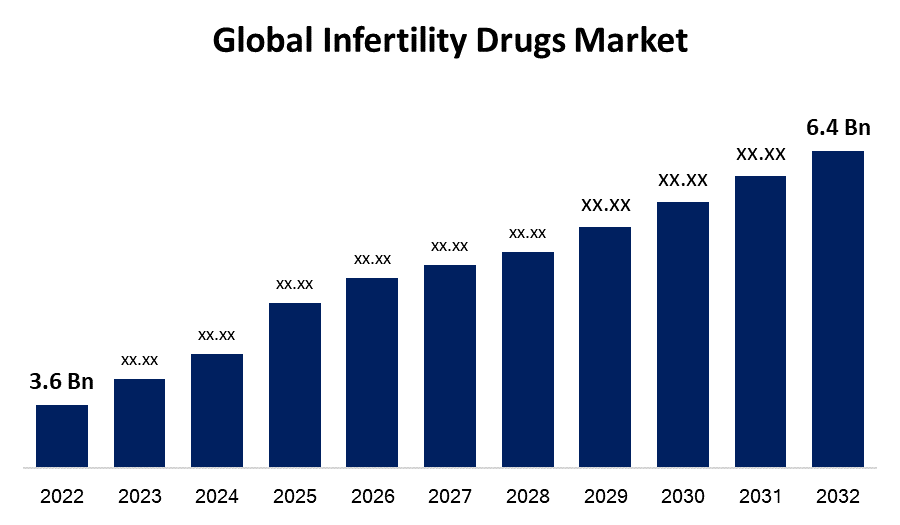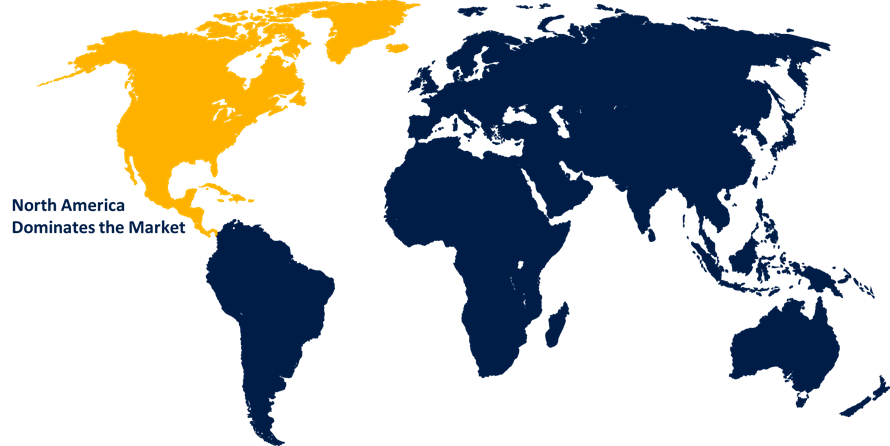Global Infertility Drugs Market Size, Share, and COVID-19 Impact Analysis, By Drug Class (Gonadotropins, Aromatase Inhibitors, SERMs, & Dopamine Agonists), By Route of Administration (Parenteral and Oral), By End-user (Men and Women), By Distribution Channel (Hospital Pharmacies, Specialty & Retail Pharmacy), By Region (North America, Europe, Asia-Pacific, Latin America, Middle East, and Africa), Analysis and Forecast 2022 - 2032.
Industry: HealthcareGlobal Infertility Drugs Market Insights Forecasts to 2032
- The Global Infertility Drugs Market Size was valued at USD 3.6 Billion in 2022.
- The Market Size is Growing at a CAGR of 5.9% from 2022 to 2032.
- The Worldwide Infertility Drugs Market size is expected to reach USD 6.4 Billion by 2032.
- Asia Pacific is expected To Grow the fastest during the forecast period.

Get more details on this report -
The Global Infertility Drugs Market Size is expected to reach USD 6.4 Billion by 2032, at a CAGR of 5.9% during the forecast period 2022 to 2032.
Market Overview
Infertility is defined medically as a woman's inability to become pregnant after nine months of unprotected sexual contact (or without the use of birth control tablets). According to the NHS, around one in every seven couples, or approximately four million individuals, has difficulty conceiving. Problems with ovulation are a prevalent cause of infertility in women. Lack of ovulation in women can be caused by polycystic ovary syndrome, thyroid difficulties (both hyperactive and underactive thyroid glands impede ovulation), and early ovarian failure, according to numerous medical practitioners. Market companies are launching innovative drugs to treat infertility. In the current instance, Oxolife is developing the first-in-class product candidate OXO-001, which is intended to improve embryo binding to the inner lining of the uterus by enhancing binding. Furthermore, the biopharmaceutical business Ferring Pharmaceuticals, located in the United States, just introduced Trisequens, a revolutionary reproductive medication for women.
Report Coverage
This research report categorizes the global infertility drugs market based on various segments and regions and forecasts revenue growth and analyses trends in each submarket. The report analyses the key growth drivers, opportunities, and challenges influencing the global infertility drugs market. Recent market developments and competitive strategies such as expansion, product launch, and development, partnership, merger, and acquisition have been included to draw the competitive landscape in the market. The report strategically identifies and profiles the key market players and analyses their core competencies in each sub-segment of the global infertility drugs market. Technological innovation and advancement will further optimize the performance of the product, enabling it to acquire a wider range of applications in the downstream market.
Global Infertility Drugs Market Report Coverage
| Report Coverage | Details |
|---|---|
| Base Year: | 2022 |
| Market Size in 2022: | USD 3.6 Billion |
| Forecast Period: | 2022-2032 |
| Forecast Period CAGR 2022-2032 : | 5.9% |
| 2032 Value Projection: | USD 6.4 Billion |
| Historical Data for: | 2018-2021 |
| No. of Pages: | 200 |
| Tables, Charts & Figures: | 110 |
| Segments covered: | By Drug, By Route of Administration, By End-user, By Distribution Channel, By Region. |
| Companies covered:: | Merck & Co., Inc., Ferring B.V., Organon Group of Companies, Abbott, Novartis AG, Bayer AG, Pfizer Inc., Mankind Pharma, Teva Pharmaceutical Industries LTD., Sanofi, Zydus Pharmaceuticals, IVFtech ApS, Vitrolife AB, and The Cooper Companies Inc. |
| Pitfalls & Challenges: | COVID-19 Empact, Challenge, Future, Growth, & Analysis |
Get more details on this report -
Driving Factors
One of the major development factors for the market is the rising prevalence of infertility throughout the world. According to World Health Organization (WHO) research, around 17.5% of the adult population, or nearly one in every six individuals globally, suffer from infertility, highlighting the critical need to enhance access to inexpensive, high-quality reproductive treatment for those in need. In addition, lifestyle changes, delayed pregnancies, environmental variables, and medical problems such as polycystic ovarian syndrome (PCOS) and endometriosis all contribute to the increased frequency of infertility. Such things will help the market flourish. Furthermore, as the world's population ages and fertility rates fall, demand for infertility treatments and medications is predicted to rise in the following year. Also, Infertility medications, as well as the existence of a variety of treatments for treating these illnesses, are likely to contribute effectively to the market. In-vitro fertilization (IVF) therapies, for example, which entail fertilizing an egg outside of the body, are becoming more frequent and are likely to boost the market's growth.
Restraining Factors
The risks and adverse effects of infertility medicines may severely impede market growth. While these medicines are intended to help couples achieve conception, they can also have risks and side effects. Headaches, mood swings, hot flashes, nausea, and bloating are some of the most prevalent adverse effects of infertility medications. Some people may have more serious problems, such as ovarian hyperstimulation syndrome (OHSS), which causes enlarged ovaries and fluid retention. OHSS can cause stomach discomfort, shortness of breath, and even death in rare circumstances. As a result, the harmful effects of infertility medications may severely impede market expansion.
Market Segmentation
- In 2022, the gonadotropins segment is dominating the market with the largest market share during the forecast period.
Based on drug class, the global infertility drugs market is segmented into gonadotropins, aromatase inhibitors, SERMs, & dopamine agonists. Throughout all segments, the gonadotropins segment has the biggest revenue share over the predicted period. This can be due to the high cost of products as well as rising usage owing to enhanced efficacy. Some of the most often used gonadotropins to treat infertility are Gonal-F, Follitism, Menopur, and Bravelle. As a result, the high effectiveness associated with gonadotropins may attract a new target audience and expand the source of revenue.
- In 2022, the parenteral segment is influencing the largest market share over the forecast period.
On the basis of the route of administration, the global infertility drugs market is classified into parenteral and oral. Among these segments, the parenteral segment is dominating the market, due to the Infertility medications are delivered directly and quickly into the bloodstream via the parenteral method, which includes injections and intravenous infusion. This results in more efficient and consistent medication absorption, leading to a speedier beginning of action and better treatment outcomes. As a result, healthcare professionals and patients are increasingly choosing parenteral administration of infertility medications, driving market developments. Furthermore, the parenteral method of administration enables accurate dosage and personalized treatment regimens, boosting market size.
- In 2022, the women segment is influencing the market with the largest market share revenue during the forecast period.
Based on drug class, the global infertility drugs market is bifurcated into men and women. Among these segments, the women segment has the biggest revenue share over the forecast period. The growth in female infertility is one of the market's primary drivers. According to the Centers for Disease Control and Prevention (CDC), approximately one in five (19%) married women aged 15 to 49 years with no past births in the United States are unable to conceive after one year of infertility. In addition, one in every four (26%) women at this age had trouble becoming pregnant or bringing a pregnancy to term (impaired fecundity). As a result, rising female infertility will hasten segmental expansion. Furthermore, the rising prevalence of Polycystic Ovary Syndrome (PCOS) among women is expected to fuel sector expansion.
- In 2022, the hospital segment is dominating the largest market share of USD 2 billion market revenue during the forecast period.
On the basis of distribution channels, the global infertility drugs market is classified into hospital pharmacies, specialty & retail pharmacies. Among these segments, the hospital segment is leading the market due to the increasing prevalence of infertility, along with increased healthcare knowledge, which will drive demand for specialist treatments. Hospital pharmacies are well-positioned to address this need and assure their availability inside the hospital context, hence driving sector trends. Furthermore, hospital pharmacists' superior pharmaceutical infrastructure and expertise, including compounding capabilities, enable customized and tailored therapies, adding to their rise in this market.
Regional Segment Analysis of the infertility drugs market
- North America (U.S., Canada, Mexico)
- Europe (Germany, France, U.K., Italy, Spain, Rest of Europe)
- Asia-Pacific (China, Japan, India, Rest of APAC)
- South America (Brazil and the Rest of South America)
- The Middle East and Africa (UAE, South Africa, Rest of MEA)
- North America dominated the market with the largest market revenue share of 38.2% during the forecast period

Get more details on this report -
North America is dominating the significant market growth during the forecast period owing to the increasing acceptance of inactive lifestyles will help the market outlook. Furthermore, the market for infertility medications in the area is rising due to a variety of reasons such as a high concentration of market participants, mergers and partnerships among important companies, and an increase in the number of infertility and PCOS patients. Also, the highly developed pharmaceutical sector, high prevalence of infertility diagnosis & treatment, and well-established healthcare infrastructure may dominate the market growth of this region.
Asia Pacific is expected to experience high revenue market growth during the forecast period due to the presence of significant players in the market and strategic measures performed by them to develop and sell innovative infertility pharmaceutical products to treat patients are credited to the region's growth. For example, the Ministry of Health, Labor, and Welfare (MHLW) authorized 12 medications for additional infertility treatment purposes in September 2022, including Novartis AG's Letrozole and Pfizer's Cabaser. This label expansion clearance was anticipated to improve the Asian Pacific market for new medications.
Competitive Analysis
The report offers the appropriate analysis of the key organizations/companies involved within the global infertility drugs market along with a comparative evaluation primarily based on their product offering, business overviews, geographic presence, enterprise strategies, segment market share, and SWOT analysis. The report also provides an elaborative analysis focusing on the current news and developments of the companies, which includes product development, innovations, joint ventures, partnerships, mergers & acquisitions, strategic alliances, and others. This allows for the evaluation of the overall competition within the market.
List of Key Companies
- Merck & Co., Inc.
- Ferring B.V.
- Organon Group of Companies
- Abbott
- Novartis AG
- Bayer AG
- Pfizer Inc.
- Mankind Pharma
- Teva Pharmaceutical Industries LTD.
- Sanofi
- Zydus Pharmaceuticals
- IVFtech ApS
- Vitrolife AB
- The Cooper Companies Inc.
Key Target Audience
- Market Players
- Investors
- End-users
- Government Authorities
- Consulting And Research Firm
- Venture capitalists
- Value-Added Resellers (VARs)
Recent Development
- In June 2022, In India, Mankind Pharma developed and introduced a generic version of Dydrogestrone pills for the treatment of patients with pregnancy-related problems. This medication was the equivalent of Abbott Duphaston pills. This introduction was expected to propel the infertility treatment market.
Market Segment
This study forecasts revenue at global, regional, and country levels from 2022 to 2032. Spherical Insights has segmented the Global Infertility Drugs Market based on the below-mentioned segments:
Global Infertility Drugs Market, By Drug Class
- Gonadotropins
- Aromatase Inhibitors
- SERMs
- Dopamine Agonists
Global Infertility Drugs Market, By Route of Administration
- Parenteral
- Oral
Global Infertility Drugs Market, By End Users
- Men
- Women
Global Infertility Drugs Market, By Distribution Channel
- Hospital Pharmacies
- Specialty
- Retail Pharmacy
Infertility Drugs Market, By Regional Analysis
- North America
- US
- Canada
- Mexico
- Europe
- Germany
- Uk
- France
- Italy
- Spain
- Russia
- Rest of Europe
- Asia Pacific
- China
- Japan
- India
- South Korea
- Australia
- Rest of Asia Pacific
- South America
- Brazil
- Argentina
- Rest of South America
- Middle East & Africa
- UAE
- Saudi Arabia
- Qatar
- South Africa
- Rest of the Middle East & Africa
Need help to buy this report?